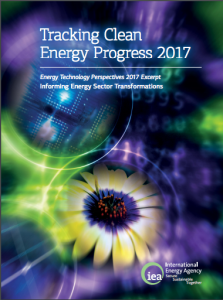Full Title: Tracking Clean Energy Progress 2017
Author(s):
Publisher(s): International Energy Agency
Publication Date: June 1, 2017
Full Text: Download Resource
Description (excerpt):
Energy systems around the world are undergoing substantial changes. Many of these shifts are being driven by purposeful government policies, whether to put a country on a low-carbon transition path, reduce air pollution, secure energy independence and security, or reduce costs and improve efficiencies. Other changes are being driven by external forces, including broader movements in energy markets or by deep societal transformations such as the increased use of information and communications technologies in every wake of life.
In order to navigate this ever-changing energy landscape, governments, companies, and other stakeholders need information. It is critical to know where we are before knowing where we want to go. What is the existing state of technologies across different parts of the energy sector, where are governments steering their energy systems, what progress is being made and how can their goals be achieved efficiently and cost-effectively?
The IEA Tracking Clean Energy Progress (TCEP) provides such a tool, and can help governments, companies, and other stakeholders build cleaner and more sustainable energy systems. Different technologies will of course be more or less relevant in different countries, which is why TCEP takes a broad and technology-neutral approach that covers a full range of energy subsectors – from bioenergy to nuclear, from building envelopes to key industries, from solar photovoltaics to carbon capture and storage (CCS).
This year, the report includes a special feature on clean energy innovation, which brings the world’s best data on public and private investment in research, development, and demonstration (RD&D) in one place. This should be helpful to all global actors, but especially for those countries involved in Mission Innovation who have pledged to double their clean energy innovation budgets over five years as well as for key private sector actors like the Breakthrough Energy Coalition.
These public and private efforts carry enormous potential to help develop the technologies of tomorrow. These efforts will be critical to help countries achieve the long-term goals of the Paris Agreement on climate change but also to reduce air pollution, bolster energy security and invigorate the economies of tomorrow.
Thanks to its growing family of member and partner governments, wide and deep business partnerships, and unparalleled expert analysts, which includes 6 000 global experts in its Technology Collaboration Programmes, the IEA strives to help the world achieve its energy policy goals – and do so efficiently and effectively. Progress has been made to ensure that IEA analysis is more accessible, and a new interactive web portal for TCEP has been created on the IEA website. It is my hope that TCEP 2017 is useful in our shared effort to promote sustainable and secure energy systems for the future.
